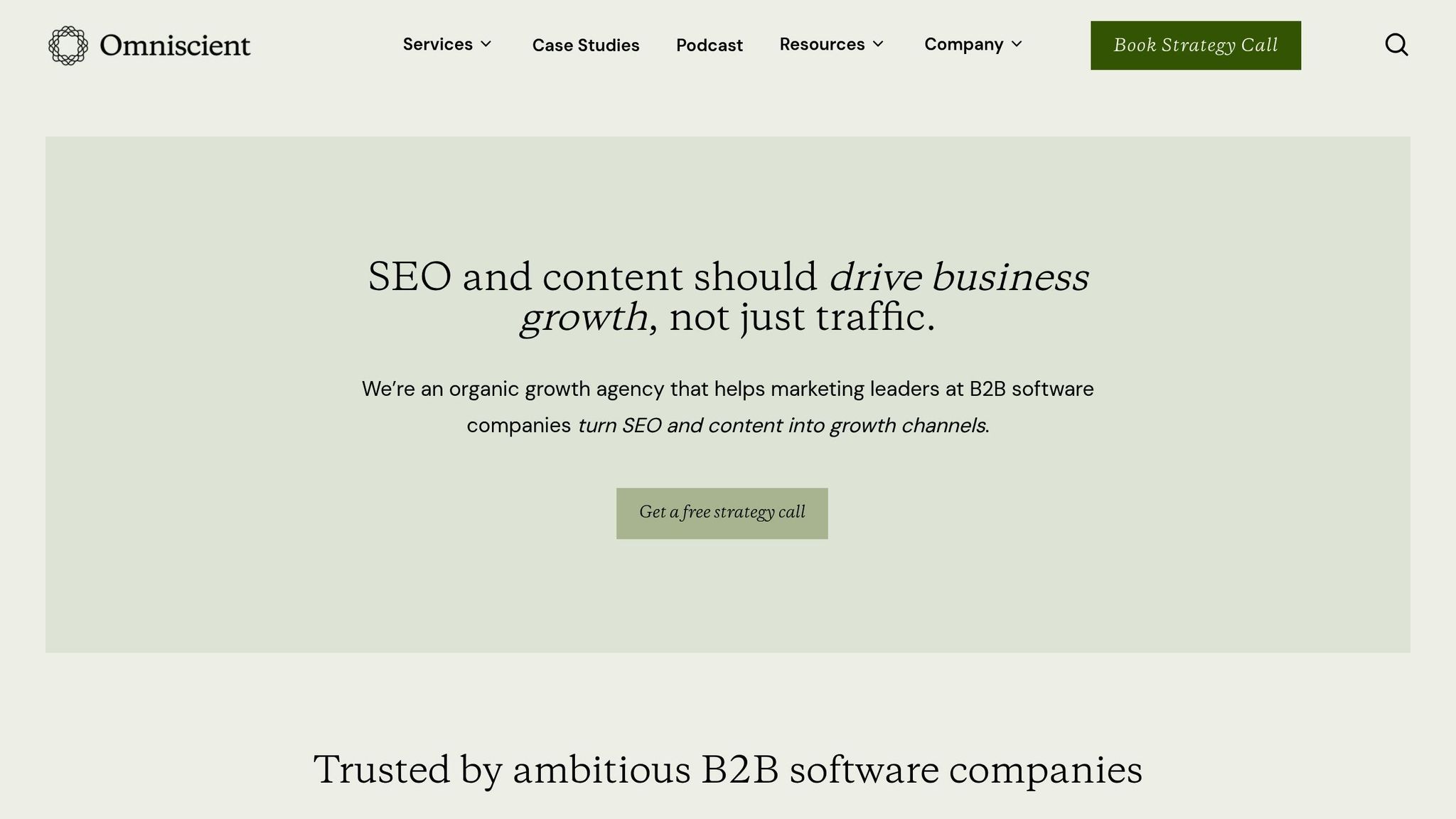Want to know if your B2B content campaigns are worth the investment? Start by calculating ROI (Return on Investment). Here's a quick guide:
- What is ROI? It's a percentage or ratio showing how much revenue your content generates compared to its costs. For example, a 400% ROI means you earned $4 for every $1 spent.
- Why it matters: ROI proves your content's financial impact, helps secure budgets, and guides smarter spending. For instance, email marketing often delivers $36 for every $1 spent.
- Challenges: B2B sales cycles are long, with multiple decision-makers and touchpoints. Proper attribution and tracking tools are key to accurate ROI measurement.
- Formula: ROI = [(Revenue – Costs) / Costs] × 100. Example: If your campaign costs $10,000 and generates $50,000, your ROI is 400%.
Key Steps to Measure ROI:
- Set clear goals and KPIs (e.g., qualified leads, reduced sales cycles).
- Track all costs (content creation, distribution, tools, and time).
- Link revenue to content using multi-touch attribution models.
- Calculate ROI and analyze results to refine strategies.
Pro Tip: Top-performing marketers measure ROI consistently and achieve ratios above 5:1. Need better results? Focus on high-impact content, optimize distribution, and leverage AI tools for tracking.
ROI isn't just a number - it’s your roadmap to smarter, more profitable campaigns.
The ROI Formula for B2B Content Campaigns
Basic ROI Formula
When calculating the ROI for B2B content campaigns, the formula is straightforward: [(Revenue - Costs) / Costs] × 100. This calculation shows the return for every dollar you spend.
Here’s how it works: Revenue refers to the total value generated, like direct sales, qualified leads, or other measurable outcomes. Meanwhile, costs include everything from content creation and distribution to tools and software.
For example, if your campaign generates $50,000 in revenue and costs $10,000 to execute, the ROI would be [($50,000 - $10,000) / $10,000] × 100 = 400%. In simpler terms, you earn $4 for every $1 you invest.
Interestingly, research shows that 90% of top-performing B2B marketers actively measure their content’s performance, compared to just 39% of their lower-performing peers.
ROI as a Ratio
Another way to present ROI is as a ratio, which many find more intuitive. Instead of percentages, you express the return as "X:1", showing how many dollars you earn for every dollar spent.
For instance, a 400% ROI translates to a 5:1 ratio, meaning $5 earned for every $1 invested. This format is especially helpful in executive presentations, where decision-makers often prefer quick, digestible insights.
Ratios also make it easier to compare campaigns or channels. For example, if your email marketing delivers a 6:1 ratio while your social media campaigns achieve 3:1, it’s clear that email is driving better returns. This insight allows you to allocate resources more effectively.
Example: Positive and Negative ROI
Real-world examples highlight the importance of ROI calculations. Take SAP SE, for instance. By focusing on early-stage prospects with high-ranking organic content, they generated nearly 1,000 leads and $750,000 in revenue from a $100,000 investment. The result? A 650% ROI. Similarly, Capgemini’s storytelling-focused website brought in $1 million in sales during its first year, eventually scaling to $20 million annually.
Understanding the difference between positive and negative ROI is critical. A 100% ROI means you’ve broken even - your revenue equals your costs. Anything above that indicates profit, while anything below signals a loss.
For example, if you spend $25,000 on a campaign but only generate $15,000 in revenue, the ROI calculation would be [($15,000 - $25,000) / $25,000] × 100 = –40%. This means you’ve lost $0.40 for every dollar spent. Negative ROI like this suggests it’s time to reevaluate your strategy, targeting, or how you track results.
To avoid losses, meticulous cost tracking and accurate revenue attribution are essential. Plus, content marketing offers a compelling advantage - it costs 62% less than traditional marketing while generating three times as many leads.
How to Model and Predict ROI from Content Marketing: David Khim (Omniscient Digital)

How to Measure B2B Content Campaign ROI
Measuring ROI for B2B content campaigns requires a structured approach to ensure accuracy and actionable insights. Here's a step-by-step guide to help you get it right.
Step 1: Set Campaign Goals and KPIs
Before launching a campaign, define clear, measurable objectives linked directly to your business outcomes. Avoid vague goals - be specific. For instance, aim to generate 500 qualified leads, reduce sales cycles by 15%, or increase customer lifetime value by $10,000.
Your KPIs should align with these objectives. Key metrics to track include lead conversion rates, average deal size, sales cycle duration, and customer acquisition cost. For example, if your focus is lead generation, monitor metrics like cost per lead, lead-to-customer conversion rate, and average sales price. Each KPI should have a clear calculation method and assigned ownership within your team.
Top-performing B2B marketers prioritize business-focused KPIs like closed revenue, pipeline creation, and sales velocity over vanity metrics such as page views or social media followers. With solid goals and KPIs, you can effectively track your campaign's financial commitment.
Step 2: Track All Content Costs
Once goals are set, shift focus to tracking every expense. Many marketers struggle here, but capturing a complete view of costs is essential. Go beyond obvious expenses like ad spend and include:
- Direct Content Costs: Expenses for content creation, team compensation, technology tools, and operational overhead.
- Team and Technology Costs: For example, a freelance content strategist may charge $2,000–$8,000 per month, and you'll also need to account for software subscriptions, analytics tools, and CRM platforms.
- Time Investment: Document time spent on strategy, content reviews, campaign management, and analysis.
Be sure to focus on incremental costs - if existing resources are used across multiple campaigns, allocate costs proportionally to avoid inflating your totals. Once costs are recorded, the next step is linking revenue.
Step 3: Connect Revenue to Content
Attributing revenue to specific content is often the trickiest part of ROI measurement. To succeed, integrate your marketing platforms with your CRM to trace revenue back to individual content pieces.
This is challenging because the average B2B buyer interacts with 31 touchpoints before making a purchase and consumes over 11 pieces of content before engaging with sales. Simple attribution models like first-touch or last-touch are insufficient for this complexity.
"At Conductor, we rely on a multi-touch attribution model. By being able to report on every step in the customer journey, we're able to get specific insights on which content, campaigns, and website pages are impacting that journey - providing the data needed to maximize ROI by investing in the efforts that drive customers further down the funnel."
- Ellie von Reyn, Senior Director, Demand Generation, Conductor
Multi-touch attribution offers the most comprehensive view by assigning credit to multiple touchpoints throughout the customer journey. To implement this, use tools like device fingerprinting, server-side tracking, and consent-based tracking to capture both online and offline interactions. A Customer Data Platform (CDP) can serve as the backbone for collecting and organizing this data.
With costs and revenue linked, you're ready for the final calculation.
Step 4: Calculate ROI
Once you've gathered all cost and revenue data, use the formula [(Revenue – Costs) / Costs] × 100 to calculate your ROI percentage. However, don't stop there - analyze the results in a broader context.
Track your total influenced pipeline to understand how marketing investments impact the entire sales funnel, not just closed deals. Monitor pipeline velocity over time to identify which campaigns shorten sales cycles most effectively.
You can also calculate quarterly marketing ROI by dividing total spend by closed/won revenue. This helps you spot performance trends, seasonal shifts, and overall campaign effectiveness. Research shows that strong B2B content marketing campaigns often achieve ROI ratios above 5:1.
Test different attribution models to find the one that best fits your business. Build a reporting system that includes executive dashboards for high-level insights and detailed reports for tactical adjustments.
Finally, remember the broader benefits of content marketing: it costs 62% less than traditional methods while generating three times as many leads. Email marketing alone delivers a $36 return for every dollar spent, and 83% of marketers report strong ROI from video content. Accurate ROI measurement not only validates your efforts but also informs smarter strategies for future campaigns.
sbb-itb-01010c0
Other Metrics for Measuring Content ROI
While ROI focuses on direct returns, it doesn’t always capture the full picture of your content's impact within the B2B sales cycle. To truly understand how your content contributes to business growth, you need to track additional metrics like lead generation, customer value, and funnel conversion. These metrics provide a broader view of how content supports your overall strategy.
Lead Generation Metrics
Lead generation metrics show how effectively your content turns prospects into potential customers. For instance, 89% of top marketers rely on performance metrics to evaluate their campaigns' success.
- Marketing Qualified Leads (MQLs): These are prospects identified as interested based on your marketing efforts. To calculate the cost per MQL, divide your total marketing spend by the number of new leads generated.
-
Sales Qualified Opportunities (SQOs): These represent leads that your sales team believes are highly likely to convert. As Liam Bartholomew, Global Head of Demand Generation at Cognism, explains:
"An SQO is a sales rep, saying, 'I think this could close,' and you want to be generating as many of those as possible. It's important to note that all SQOs are not the same. Although indicative of a successful campaign, your incoming revenue is the most honest indicator of campaign success."
Breaking down customer acquisition costs (CAC) by channel can highlight which channels are most efficient. Organic search, for example, drives 53% of all traffic to business websites. Alice de Courcy, Chief Marketing Officer at Cognism, suggests:
"When reporting to the board, the revenue-focused marketer is also going to be looking to report on CAC - this is the customer acquisition cost. Break down your CAC across your 'channels'. For Cognism, those are inbound, paid and content. This enables you to see which channels are more efficient and scaling better."
Customer Value and Retention Metrics
Beyond generating leads, it’s essential to measure the long-term value of your customers. Customer Lifetime Value (CLV) estimates the total revenue you can expect from a customer throughout your relationship. This metric is particularly useful in B2B content marketing, where nurturing relationships often leads to increased customer loyalty and revenue.
Retaining customers is not only cost-effective but also drives more revenue. Studies show it costs five times more to acquire a new customer than to retain an existing one. Plus, existing customers are 50% more likely to try new products. Lauren O'Brien, Chief Revenue Officer at Cloudastructure, underscores this point:
"Customer retention, of course, is key in this game. You would be surprised how you can improve your pricing and sales strategy and accelerate sales by understanding these metrics."
Using CLV data can also help you identify your most valuable customer segments and refine your content strategies to target them. Alex Schlee, founder and CEO of Anamap, notes:
"Used for comparison purposes, CLV also allows companies to find high-value segments of customers and optimize toward getting additional customers from that segment."
Additionally, tracking how your content supports upselling and cross-selling opportunities can further boost customer value without the high costs associated with acquiring new customers.
Sales Funnel Conversion Rates
Measuring how prospects move through your sales funnel offers another way to assess content performance. This approach focuses on how content helps guide potential customers toward making a purchase. It’s worth noting that 48% of marketers prioritize improving sales funnel efficiency, while 96% of visitors aren’t ready to buy when they first visit your site.
Here’s a breakdown of typical conversion rates at each funnel stage:
- Visitor-to-Lead: 1–3%, often driven by blog posts, gated content, and landing pages.
- Lead-to-MQL: 10–15%, reflecting strong interest shown through content engagement.
- MQL-to-SQL: 20–30%, indicating readiness for sales conversations.
- SQL-to-Opportunity: 30–40%, showing progress toward active sales discussions.
- Opportunity-to-Customer: 20–30%, representing final conversions into paying customers.
| Funnel Stage | Conversion Rate | Key Content Types |
|---|---|---|
| Visitor-to-Lead | 1–3% | Blog posts, gated content, landing pages |
| Lead-to-MQL | 10–15% | Email nurturing, educational content |
| MQL-to-SQL | 20–30% | Product-focused content, case studies |
| SQL-to-Opportunity | 30–40% | Sales enablement materials, demos |
| Opportunity-to-Customer | 20–30% | ROI calculators, implementation guides |
Since 61% of marketers cite lead generation as their biggest challenge, tracking these metrics can help pinpoint which content pieces are most effective at converting prospects into customers. Together, these insights provide a clearer picture of how your content influences the entire customer journey, helping you refine your strategy for both immediate and long-term results.
Key Takeaways for B2B Content Campaign ROI
Measuring ROI for B2B content campaigns becomes manageable when you have reliable data, thorough tracking, and the right tools to connect your content efforts to revenue. These elements lay the groundwork for an accurate ROI assessment.
ROI Calculation Summary
ROI evaluates the revenue generated compared to the investment made, using the formula: [(Revenue – Costs) / Costs] × 100. To calculate it effectively, you need to track both sides of the equation - every dollar spent and every dollar earned.
Make sure to account for all costs tied to your marketing efforts, such as team salaries, advertising expenses, and software subscriptions. Without accurate data, it’s nearly impossible to attribute ROI correctly, which is why investing in clean, reliable data collection is critical.
Beyond revenue, focus on metrics like Marketing Qualified Leads (MQLs), Sales Qualified Leads (SQLs), and Customer Lifetime Value (CLV). These are especially relevant in B2B, where sales cycles are typically longer.
For benchmarks, a 5:1 ROI ratio is often seen as strong. Studies show that ROI in marketing campaigns can range between 317% and 1,389%, with an average of around 748%. A 5:1 (or 500%) marketing ROI is excellent, while anything below 2:1 (200%) may indicate underperformance. These benchmarks help you gauge the success of your content strategy.
Tips for Better ROI Results
Once you’ve calculated ROI, it’s time to refine your approach for better outcomes. Start by aligning each marketing initiative with your business goals and setting up a solid reporting framework to track performance and accurately tie revenue back to your efforts. Surprisingly, as of 2022, only 53% of marketers reported basing their decisions on data, according to Gartner.
Focus on creating content that drives measurable results. Build your strategy around addressing customer pain points - not just targeting keywords. Use tactics like case studies as lead magnets, repurpose long-form content across multiple platforms, and organize content into topic clusters to enhance SEO and nurture leads.
Distribution matters as much as creation. Ensure your content reaches decision-makers through channels like email and social media. Use a content distribution checklist to stay consistent, and include calls-to-action that match your audience’s buying intent.
Invest in evergreen content that delivers long-term value and track metrics that align with your broader business objectives. Additionally, leverage AI tools - such as those provided by The B2B Ecosystem - to automate data collection, analyze customer behaviors, and optimize content performance using real-time insights. These tools can help you make smarter, faster decisions that drive better results.
FAQs
How can I link specific content to revenue in a complex B2B sales cycle?
To link specific content to revenue in a complex B2B sales cycle, try using a multi-touch attribution model. This approach looks at every content interaction that influences a lead's journey, not just the final touchpoint. By tracking how prospects engage with assets like blog posts, whitepapers, and webinars, you can figure out which pieces of content play a role in driving conversions and generating revenue.
The key to making this work is integrating marketing and sales data. Tools that combine lead tracking with revenue analytics can help you identify the content that has the biggest impact. Regularly reviewing and adjusting your attribution model ensures your strategy stays in sync with business goals and provides insights you can act on.
What are the best ways to improve ROI for B2B content campaigns?
To get better ROI from B2B content campaigns, here are some practical strategies to consider:
- Repurpose high-performing content: Take your best content and give it new life. For example, transform a successful blog post into a video, infographic, or even a podcast episode. This allows you to connect with different audience segments and adapt to their preferences.
- Focus on your audience's needs: Tailor your content to solve the specific challenges your target audience faces. Build detailed buyer personas to ensure your messaging aligns with their goals and keeps them engaged.
- Use data to guide your strategy: Pay close attention to metrics like engagement rates and conversions. These insights reveal what’s working and help you refine your approach to focus on content that delivers the most impact.
These steps can help you create campaigns that not only engage your audience but also deliver stronger returns on your investment.
Why should you track both direct and indirect costs when calculating ROI for B2B content campaigns?
Tracking direct and indirect costs is key to accurately figuring out the ROI of your B2B content campaigns. Direct costs, like paying for content creation, design, or distribution, are pretty easy to calculate. On the other hand, indirect costs - things like staff hours, software tools, or overhead - can add up and have a big impact on your total investment.
When you account for both types of costs, you get a clearer view of your overall marketing spend. This clarity helps you measure the actual profitability of your campaigns, fine-tune how you allocate resources, and make smarter decisions for future efforts. Taking this thorough approach ensures you evaluate every dollar spent against the revenue it brings in, ultimately leading to better strategies and stronger results.


